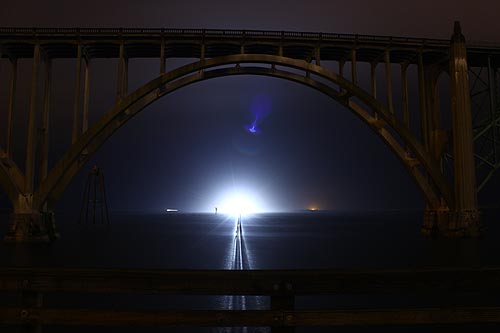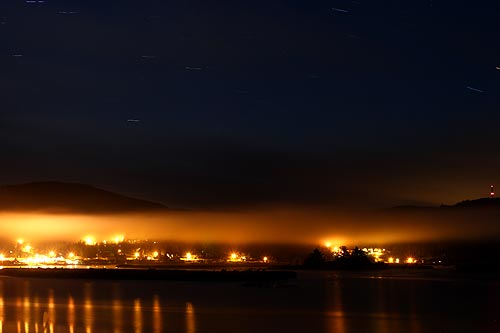 |
Summer Just Got a Little More Otherworldly on Oregon Coast
Published 08/06/2013

(Oregon Coast) – It's the perfect storm of strangeness on the Oregon coast right now, one of sizable surrealism. Some of summer's most interesting phenomena start happening around this time, but now it's given the extra boost of a space station flying overhead. Look up again and you may see a whole lot of shooting stars. But look down at the ocean sand and you may see shooting stars below you as well. (Above: stars at Cannon Beach)
All of it happens at night, too.
Currently, the Perseid Meteor showers are ramping up, with their climax happening in a week. The International Space Station is making some spectacular appearances. Then, if you're at the right place at the right time on a nocturnal beach, you could well see the coveted “glowing sand.”

The Perseid Meteor showers have already begun. The peak of this display is predicted to be August 12, 5:15 am to August 13, 4:45 pm PDT. But the shower lasts until August 24, so OMSI planetarium manager Jim Todd suggested you can still see some good little fireballs on either side of the peak. (Above: Manzanita)
These and other meteor showers happen when this planet wanders through debris paths left by comets zooming past, as the tiny particles burn up in the Earth's atmosphere. Todd said these little bits of rock and dust are meteoroids, and they hit the outer atmosphere at thousands of miles an hour.

“Most are destroyed during entry; the rare few that survive and hit the ground are known as meteorites,” Todd said. (Above: Seaside, Oregon at night)
The Perseids come from a comet called Swift-Tuttle, which last swung this way in December 1992.
Also visible until August 24 is the International Space Station, which has already made some stunning sights in inland Oregon – but so far the Oregon coast has been fairly overcast at night. There have been some quite bright flyovers, just like back in June.

Two other very bright showings will occur again on Wednesday and Thursday. Wednesday's appearance is close to 10 p.m. at a magnitude -2.9 and another the following night even brighter just a few minutes after 9 p.m. Other extremely bright sightings will happen on August 18 and 19, but according to the ISS schedule from Heaven's Above you can see it sometimes as much as two or three times a night through this month. (Above: Yachats, Oregon at night)
If you hit the beaches in August looking for any of these sights, make sure you look down as well. You might just spot some positively illuminating little creatures called dinoflagellates, which are a form of bioluminescent phytoplankton.

They show up in the sand as tiny, greenish-bluish sparks, mostly in wet sand that is near where the tide is at that moment. You'll need to find a very dark beach at night, with no light interference from street lights or the moon – which means you may have to wait for a cloudy night or until the moon descends. (Above: a closeup of a dinoflagellate - photo Dr. Edith Widder, www.teamorca.org )
Rub your feet in the sand, going backwards, and as the sand kicks up you'll see those tiny flashes of light.

If you're really lucky, they'll be lurking in a pool of water and what you'll see is a sudden galaxy of teeny stars explode under your foot. (Above: Newport, Oregon at night)
These nearly-microscopic plant-creatures are bioluminescent, like fireflies. They give off a sudden glow when their cell wall is touched.
To find them, look to the still-wet sand near the tide line. But be extremely careful to watch the waves at night. Keep beach safety in mind.

Sometimes, these can be seen in coastal bays, such as the Nehalem Bay. If you're on a dock where the water is within reach – such as at Wheeler's waterfront – put your hand in the water and move it around. If there, it will show up as a ghostly blue glow behind your hand. (Above: Wheeler, Oregon at night)
More About Oregon Coast hotels, lodging.....
More About Oregon Coast Restaurants, Dining.....
Back to Oregon Coast
Contact Advertise on BeachConnection.net
All Content, unless otherwise attributed, copyright BeachConnection.net Unauthorized use or publication is not permitted
Secrets of the Season |
Unusual Travel Articles TravelParanormal.com allows you to submit your own creepy tale or debunk one - or see up-to-the-minute news headlines about travel and the paranormal. News Headlines from All Over Oregon Need to scan Oregon headlines? Constantly updated news from all over Oregon: a comprehensive, up-to-the-minute display of news headlines from a variety of media |
Decay Hits Beloved Oregon Coast Tree, Now the Newport Icon Must Be Cut Down |









































